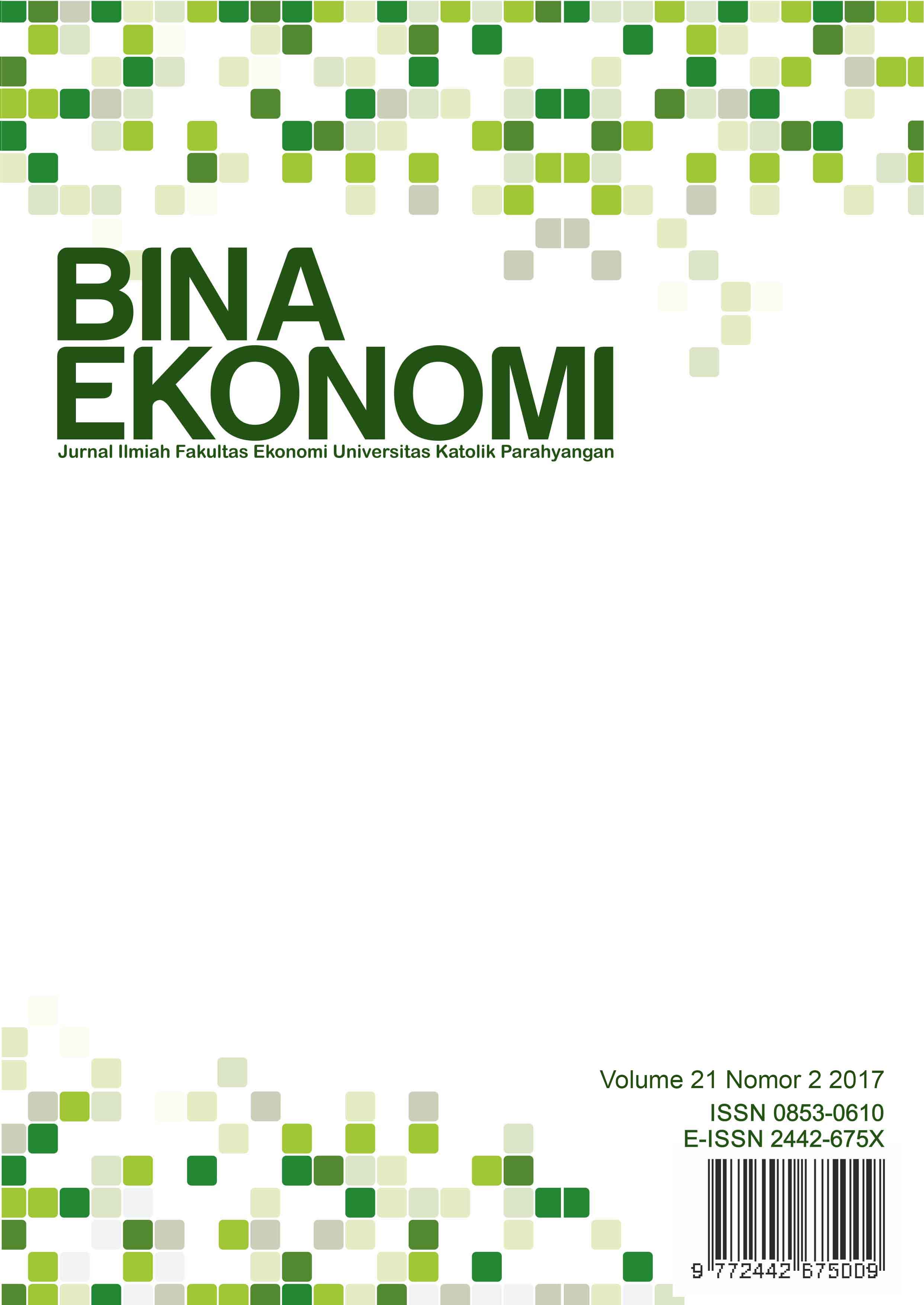AFTA DAN KUALITAS LINGKUNGAN HIDUP DI INDONESIA
DOI:
https://doi.org/10.26593/be.v21i2.2998.181-202Abstract
The effect of economic integration on environmental quality in the member country is still debatable. Economic intergration is believed to increase economic activity in the country, and if Environmental Kuznets Curve (EKC) hypothesis is confirmed, increased national income will accelerate the environmental quality improvement. Indonesia is the member of several economic integrations, including AFTA. This study aims to investigate the effect of AFTA on environmental quality in Indonesia, through investigating Environmental Kuznets Curve (EKC). An Ordinary Least Square (OLS) regression analysis is employed, and CO2 emission as environmental quality indicator is used as dependent variable (it was planned that this study also used forest cover, and SO2 emission, as dependent variables; but data limitation problem on those variables has withdrawn the plan). Two independent variables, namely: number of population and economy opennes, other than Indonesia’s GDP per capita. The result suggests that AFTA does not affect the environmental quality in Indonesia.
Keywords: Economic Integration, AFTA, environmental quality, Environmental Kuznets Curve
References
Antweiler, W., Copeland, B. R., & Taylor, M. S. (2001). Is free trade good for the environment? The American Economic Review, 91(4), 877-908.
Azhar, U., Khalil, S., & Ahmed, H. (2007). Environmental effects of trade liberalisation: a case study of Pakistan. The Pakistan Development Review, 46(4), 645-655.
Badan Pusat Statistik. (1981). Statistik Indonesia 1981. Badan Pusat Statistik.
Badan Pusat Statistik. (1982). Statistik Indonesia 1982. Badan Pusat Statistik.
Badan Pusat Statistik. (1984). Statistik Indonesia 1984. Badan Pusat Statistik.
Badan Pusat Statistik. (1986). Statistik Indonesia 1986. Badan Pusat Statistik.
Badan Pusat Statistik. (1988). Statistik Indonesia 1988. Badan Pusat Statistik.
Badan Pusat Statistik. (1990). Statistik Indonesia 1990. Badan Pusat Statistik.
Badan Pusat Statistik. (1992). Statistik Indonesia 1992. Badan Pusat Statistik.
Badan Pusat Statistik. (1994). Statistik Indonesia 1994. Badan Pusat Statistik.
Badan Pusat Statistik. (1996). Statistik Indonesia 1996. Badan Pusat Statistik.
Badan Pusat Statistik. (1998). Statistik Indonesia 1998. Badan Pusat Statistik.
Badan Pusat Statistik. (2000). Statistik Indonesia 2000. Badan Pusat Statistik.
Badan Pusat Statistik. (2002). Statistik Indonesia 2002. Badan Pusat Statistik.
Badan Pusat Statistik. (2004). Statistik Indonesia 2004. Badan Pusat Statistik.
Badan Pusat Statistik. (2006). Statistik Indonesia 2006. Badan Pusat Statistik.
Badan Pusat Statistik. (2008). Statistik Indonesia 2008. Badan Pusat Statistik.
Badan Pusat Statistik. (2010). Statistik Indonesia 2010. Badan Pusat Statistik.
Badan Pusat Statistik. (2012). Statistik Indonesia 2012. Badan Pusat Statistik.
Badan Pusat Statistik. (2014). Statistik Indonesia 2014. Badan Pusat Statistik.
Badan Pusat Statistik. (2015). Statistik Indonesia 2015. Badan Pusat Statistik.
Badan Pusat Statistik. (2016). Penduduk 15 tahun ke atas yang bekerja menurut lapangan pekerjaan utama 1986 – 2016. Badan Pusat Statistik.
Bowles, P. (1997). ASEAN, AFTA, dan the "new regionalism". Pasific Affairs, 70(2), 219-233.
Copeland, B. R., & Taylor, M. S. (2004). Trade, growth, and the environment. Journal of Economic Literature, 42(1), 7-71.
Dean, J. M. (2002). Does trade liberalization harm the environment? a new test. The Canadian Journal of Economics/Revue canadienne d'Economique, 35(4), 819-842.
Down to Earth. (2002). Forests, people, and right (special report). Down to Earth.
Gallagher, K. P. (2004). Economic integration and the environment in Mexico: lessons for future trade agreements. Working Group on Development and Environment in the Americas. Discussion Paper, 6, 1-20.
Ghose, M. K., & Majee, S. R. (2000). Source of air pollution due to coal mining and their impacts in Jharia coalfield. Environment International, 26(1-2), 81-85.
Grossman, G. M., & Krueger, A. B. (1991). Environmental impacts of a North American free trade agreement. Natural Bureau of Economic Research Working Paper no. 3914, 1-39.
Gujarati, D.N. (2004). Basic Econometric, (4th Ed.). The McGraw-Hill Companies. NewYork.
McCarney, G., & Adamowicz, W. L. (2005). The effects of trade liberalization on the environment: an empirical study. Annual Meeting, July 6-8, 2005. San Fransisco, CA 34157: Canadian Agricultural Economics Society.
Measey, M. (2010). Indonesia: a vulnerable country in the face of climate change. Global Majority E-Journal, 1(1), 31-45.
Naidoo, R., & Adamowicz, V. L. (2001). Effect of economic prosperity on numbers of threatened species. Conservation Biology, 15(4), 1021-1029.
Nordström, H., & Vaughan, S. (1999). Special studies 4: Trade and environment. Retrieved from WTO Publication: https://www.wto.org/english/res_e/publications_e/special_studies4_e.htm
Okabe, M., & Urata, S. (2013). The impact of AFTA on Intra-AFTA trade. ERIA Discussion Paper Series No. 2013-05, 1-43.
Shen, J. (2008). Trade liberalization and environmentla degradation in China. Applied Economics, 40, 997-1004.
Smith, S. J., Van Aardanne, J., Klimont, Z., Andres, R. J., Volke, A., & Delgado, A. S. (2011). Anthropogenic sulfur dioxide emissions: 1850–2005. Atmospheric Chemistry and Physiscs, 11(3).
Sunderlin, W., & Resosudarmo, I. A. (1996). Rates and causes of deforestation in Indonesia: towards a resolution of the ambiguities. Occasional Paper No. 9, 1-19.
Tariq, B., & Rahim, R. A. (2016). The environmental effects of intra-industry trade in the SAARC region. International Journal of Business and Society, 17(1), 113-130.
United Nations. (1999). Trade liberalisation and the environment: lessons learned from Bangladesh, Chile, India, Philippines, Romania and Uganda. United Nations.
Verico, K. (2015). Open-ended impact of AFTA on FDI inflows: evidence from macro-level data of Indonesia, Malaysia, Thailand and firm-level data of Indonesia. Journal of Economic Cooperatioin and Development, 36(2), 91-124.
World Bank. (2016a). CO2 emissions (kt). Retrieved from http://data.worldbank.org/indicator/EN.ATM.CO2E.KT?view=chart
World Bank. (2016b). GDP (current US$). Retrieved from http://data.worldbank.org/indicator/NY.GDP.MKTP.CD?view=chart
World Bank. (2016c). Forest area (sq. km). Retrieved from http://data.worldbank.org/indicator/AG.LND.FRST.K2
World Bank. (2016d). Population, total. Retrieved from http://data.worldbank.org/indicator/SP.POP.TOTL?view=chart


